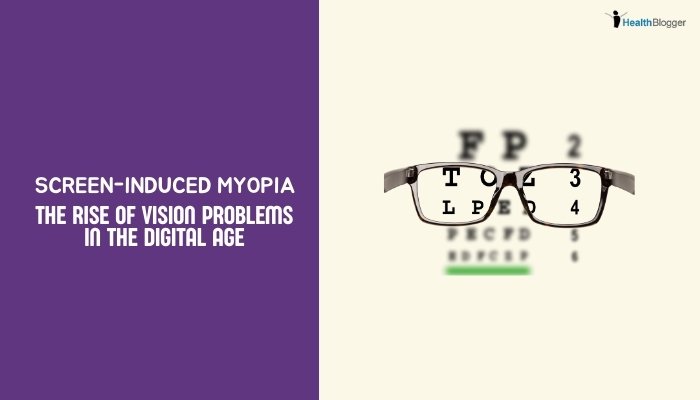Excessive screen time and reduced outdoor activity are fueling a surge in nearsightedness (myopia), especially among children and teens. Recent studies warn that by 2050, nearly half of the world’s population could be myopic.

Beyond needing glasses or contact lenses, long-term myopia increases the risk of serious eye conditions, including retinal detachment and glaucoma. This article examines how our digital lifestyles contribute to myopia, outlines potential long-term impacts, and offers practical preventive strategies.
Introduction
The rapid adoption of smartphones, tablets, and computers has reshaped daily life. While these devices enhance communication and productivity, their extended use is linked to screen-induced myopia. Recent research indicates that children and teens spending long hours on digital screens are experiencing higher rates of nearsightedness. With predictions that up to 50% of the global population could be myopic by 2050, the implications extend beyond the need for corrective lenses—chronic myopia can predispose individuals to severe retinal and vision problems later in life.
Understanding Myopia
What Is Myopia?
- Definition: Myopia, or nearsightedness, is a common refractive error where distant objects appear blurry while close objects are seen clearly.
- Causes: It occurs when the eye grows too long or the cornea curves excessively, causing light to focus in front of the retina.
Prevalence and Trends
- Increasing Rates: Studies show a dramatic rise in myopia, particularly in urban populations with heavy digital exposure.
- Global Impact: Estimates suggest that by 2050, nearly half of the world’s population may suffer from some degree of myopia.
Digital Screens and Myopia
Role of Excessive Screen Use
- Prolonged Near Work: Reading or staring at screens for extended periods forces the eyes to focus at close range, potentially triggering elongation of the eyeball.
- Reduced Blink Rate: Digital engagement often reduces blinking, which can strain the eyes.
- Visual Fatigue: Continuous screen use without breaks can lead to eye strain and worsen refractive errors over time.
Lack of Outdoor Exposure
- Natural Light Benefits: Exposure to daylight is crucial for healthy eye development. Studies suggest that outdoor time can slow myopia progression.
- Contrast with Indoor Time: Children spending most of their day indoors on screens miss out on natural light’s protective effects, increasing myopia risk.
Long-Term Implications of Rising Myopia
Increased Risk of Severe Eye Conditions
- Retinal Detachment: High myopia raises the risk of the retina pulling away, which can lead to vision loss.
- Glaucoma and Cataracts: Chronic stress on the eye’s structure may contribute to the development of other vision-threatening conditions.
- Macular Degeneration: Long-term retinal stress could accelerate degenerative changes in the central retina.
Economic and Social Impacts
- Healthcare Costs: Higher prevalence of myopia may lead to increased spending on eye care, corrective lenses, and potential surgeries.
- Quality of Life: Beyond visual discomfort, the progression of myopia can limit daily activities, educational performance, and even career opportunities.
Preventive Strategies
Reducing Screen Time
- Scheduled Breaks: The 20-20-20 rule suggests that every 20 minutes, look at something 20 feet away for 20 seconds.
- Limiting Device Use: Encourage periods of digital detox, particularly for children and teenagers.
Increasing Outdoor Activities
- Daily Sunlight Exposure: Aim for at least 1-2 hours of outdoor activity each day to benefit from natural light.
- Organized Sports and Outdoor Classes: Schools and communities can offer programs that promote outdoor play and physical activity.
Ergonomic and Environmental Adjustments
- Proper Lighting: Ensure indoor environments are well-lit to reduce eye strain.
- Screen Settings: Adjust brightness and text size, and use blue-light filters on devices.
Regular Eye Examinations
- Early Detection: Annual or biannual eye exams help detect early changes in vision.
- Professional Guidance: Eye care professionals can recommend preventive measures or corrective treatments as needed.
Public Health Implications
- Awareness Campaigns: Educating families, schools, and communities about the risks of excessive screen time and the benefits of outdoor activities.
- Policy Changes: Implementing guidelines in schools to limit digital device use during lessons and encourage outdoor play.
- Healthcare Initiatives: Public health programs focusing on regular vision screening for children and adolescents.
Future Directions in Vision Health Research
- Longitudinal Studies: Research tracking children’s vision over decades to understand the full impact of screen time and outdoor exposure.
- Innovative Interventions: Developing digital tools that promote healthier screen use patterns.
- Genetic and Environmental Interactions: Investigating how genetic predispositions might interact with lifestyle factors to influence myopia progression.
Practical Tips for Parents and Youth
- Implement the 20-20-20 Rule: Encourage regular breaks during screen time.
- Prioritize Outdoor Play: Incorporate daily outdoor activities into family routines.
- Set Screen Time Limits: Use apps or parental controls to monitor and limit device use.
- Create a Healthy Home Environment: Ensure proper lighting and comfortable viewing distances for digital devices.
- Schedule Regular Eye Exams: Early detection is key to managing changes in vision.
Conclusion
The surge in screen-induced myopia is a growing public health challenge, particularly among children and teens in our digital age. With predictions that half the world’s population may be myopic by 2050, proactive measures are crucial. Balancing digital engagement with outdoor activity, optimizing screen settings, and maintaining regular eye care can help mitigate these risks. As more research unfolds, communities and policymakers must prioritize vision health to ensure that our reliance on technology does not come at the cost of our sight.
References
- Wu PC, et al. Outdoor activity during class recess reduces myopia onset and progression in school children. Ophthalmology. 2013;120(5):1080-1085.
- Jones LA, Sinnott LT, Mutti DO, Mitchell GL, Moeschberger ML, Zadnik K. Parental myopia, near work, school achievement, and children’s refractive error. Invest Ophthalmol Vis Sci. 2007;48(9):3864-3870.
- Dirani M, et al. The relationship between outdoor activity and myopia in children. Invest Ophthalmol Vis Sci. 2009;50(10):4773-4777.
- Dolgin E. The myopia boom. Nature. 2015;519(7543):276-278.
- Rose KA, Morgan IG, Ip J, Kifley A, Huynh S, Smith W, et al. Outdoor activity reduces the prevalence of myopia in children. Ophthalmology. 2008;115(8):1279-1285.
- Morgan IG, Ohno-Matsui K, Saw SM. Myopia. Lancet. 2012;379(9827):1739-1748.
- Holden BA, et al. Global prevalence of myopia and high myopia and temporal trends from 2000 through 2050. Ophthalmology. 2016;123(5):1036-1042.
- National Eye Institute. Facts About Myopia. Accessed 2023.






